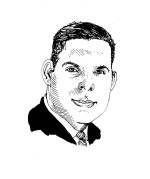 S. & P.’s downgrade of U.S. debt offered investors no new information about the quality or the riskiness of Treasury securities. It has, however, challenged foundational assumptions about the workings of the global financial system at a difficult juncture for the fragile recovery.
S. & P.’s downgrade of U.S. debt offered investors no new information about the quality or the riskiness of Treasury securities. It has, however, challenged foundational assumptions about the workings of the global financial system at a difficult juncture for the fragile recovery.
The uncertainties introduced as a result coincide with other, less qualitative measures of the U.S. economy’s performance, which generally show that the recovery has slowed.
The rating adjustment’s blow to sentiment is amplifying concerns about what these metrics imply for the outlook, prompting investors to move out of risky positions and—ironically—into the safety of Treasuries.
Against this difficult backdrop, Friday’s unemployment report offered a rare bit of positive news, but one that must be taken in context. The Bureau of Labor Statistics (B.L.S.) data show private-sector hiring in July outpacing economists’ expectations. While those expectations were decidedly reserved, it is significant that firms expanded payrolls in the midst of the incapacitation emanating from Washington.
The B.L.S. data also show that serious challenges remain, requiring a more concerted response to the historically weak job recovery trends. The share of the U.S. population gainfully employed fell to 58.1 percent in July, its lowest level in almost three decades and well below the 64.7 percent peak from 11 years ago.
With a falling share of the population employed and the unemployed remaining out of work longer, attention must refocus on tackling the structural drags on job growth and the deleterious role of policymaking in worsening labor market rigidities.
The Jobs Report by the Numbers
Seasonally adjusted private payrolls expanded by 154,000 jobs in July, the best result since April. The private increase was offset in part by an expected decline of 37,000 public jobs, almost exclusively at the state and local levels.
Nonresidential construction employment was essentially unchanged, increasing by 2,100 jobs. Nonresidential specialty contractors fared slightly better, adding 8,100 jobs. The results suggest a trough in commercial construction but not a strong rebound in activity.
In the service sector, retail employment gains were surprisingly strong. Retail employers added 25,900 jobs in July, principally at auto dealers; health and personal care stores, including pharmacies; and department stores. Overall retail employment is slightly higher than a year earlier.
The financial services sector, perhaps the most important for Manhattan’s office market, remains a weak point in the payroll data, at least at the national level. The sector shed 4,000 jobs in July and is 15,000 jobs short of its level a year earlier. In spite of the improving profits of many intermediaries, the jobs outlook is qualified by several factors, including uncertainties related to the implementation of Dodd-Frank.
Like financial services, professional and business services is one of the primary contributors to office-space demand. The sector posted a gain of 34,000 jobs in July. Computer systems registered a gain of 6,100 jobs, in a rising trend consistent with growth in technology businesses. However, an even larger share of professional jobs was recorded in relatively lower-wage administrative and support services.
Gains in the leisure and hospitality sector were confined to the first of its two components, with a healthy increase in arts and entertainment employment. Still, employment across the range of accommodation types increased by 2,700 jobs, and is up roughly 2 percent on a year earlier.
Real Estate Implications
Labor market trends are still falling woefully short of real estate investment and credit trends, with the result that pricing improvements for lower-quality properties continue to lag trends for top-tier assets. Until job growth accelerates, we should not expect that spillovers from the top of the market will suffice as sustainable drivers of momentum for broader investment.
Fiscal stimulus is only one option deserving of consideration. In support of job growth, policymakers must also consider that encouraging a sense of normalcy in the business environment will prove as effective as any spending program.
dsc@chandan.com
Sam Chandan, Ph.D., is president and chief economist of Chandan Economics and an adjunct professor at the Wharton School.


